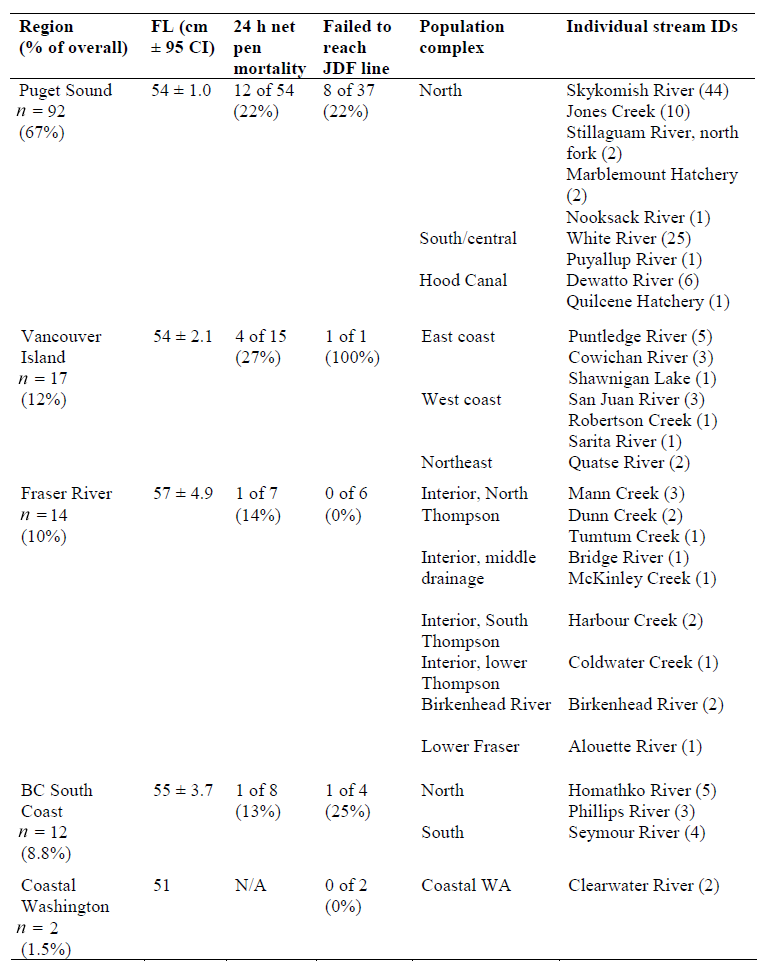
Ecological Archives A025-108-A1
Graham D. Raby, Scott G. Hinch, David A. Patterson, Jayme A. Hills, Lisa A. Thompson, and Steven J. Cooke. 2015. Mechanisms to explain purse seine bycatch mortality of coho salmon. Ecological Applications 25:1757–1775. http://dx.doi.org/10.1890/14-0798.1
Appendix A. Detailed results on population identification analyses and results on the effects of use of a smaller mesh size and use of a sorting box.
RESULTS
Population identification results
Table A1. Population-origin identification of coho salmon along with sizes and mortality rates associated with fish originating from population groups. Differences in survival among population groupings (for statistics, grouped as BC south coast, interior Fraser, Puget Sound Hood Canal, Puget Sound North, Puget Sound South/central, Vancouver Island) were not significant for either net pen mortality rates (Chi-square test: χ2 = 0.32, df = 5, P = 0.99) or for success in surviving to reach the JDF receiver line (χ2 = 0.66, df = 3, P = 0.88). Differences in fish length among population grouping were not significant (Kruskal-Wallis ANOVA; χ2 = 10, P = 0.08).

Effects of smaller mesh size and use of sorting box
Changing the gear to a smaller mesh bunt (70 mm knotless nylon) for three net sets resulted in improved condition in adult coho salmon bycatch and no immediate mortality, but high bycatch of juvenile salmon. Controlling for sampling time-course, coho salmon caught with the alternate mesh had a significantly lower PC1 response (Welch’s t test, t12 = 5.5, P < 0.001) and lower lactate (t11 = 5.8, P < 0.001), but no significant differences among the other 3 plasma variables (α = 0.01; all P > 0.02). RAMP scores were significantly lower with the small mesh (i.e., fish were more vigorous - Wilcox rank-sum test; P < 0.001) but injury scores were not significantly different (P = 0.05). For the three sets for which the mesh was used 83, 105, and 20 juvenile coho salmon were caught compared to zero juvenile fish in the standard net. Immediate mortality for juvenile coho was approximately 20% (not accurately enumerated), owing to some of the individuals being gilled and air exposed in a section of the net that becomes permanently raised above deck during the pursing process. Scale loss was high for all juvenile coho salmon we processed at the sampling trough (mean FL = 27 ± 0.2 cm). We also noted that dozens of juvenile fish could be seen escaping through the mesh below the water’s surface before landing, often with visibly evident scale loss occurring in the process.
Rapidly sorting bycatch in a dry sorting box prior to transfer to recovery totes did not result in significantly different blood physiology for the one set where it was used (P > 0.05) except for time-corrected plasma potassium, which was marginally lower for fish exposed to the sorting box (t28 = -2.8, P = 0.009). Use of the sorting box resulted in no significant differences in RAMP or injury scores (Wilcox rank-sum test, P > 0.10 for both).